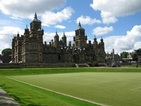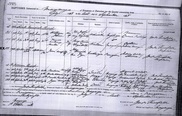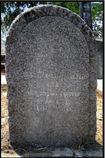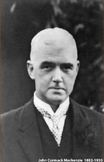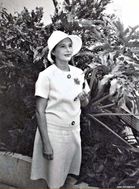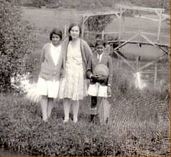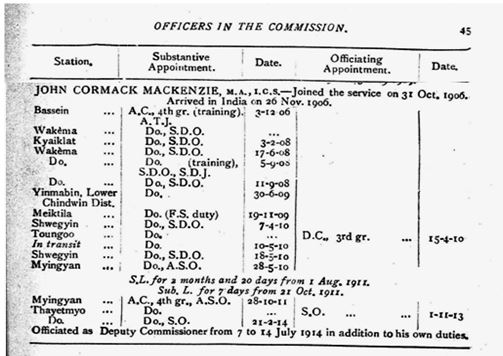John Cormack Mackenzie, M.A., I.C.S.,
Commissioner of Income Tax, 1882-1930
which has come from various sources on the net and from other generous researchers and various librarians.
My search also accidentaly put me in contact with a cousin of whose existence I was totally unaware.
She also is a grandchild of John Mackenzie and his wife, Ruby.
It is to her and her husband, John, that I am grateful for editing and providing new material for this search.
Quite recently David has also supplied us with more wonderful photos which include his parents, grand parents,uncle, great aunt and their friends
together with lovely group photos and historic buildings, St. Michael's School among them.
Grandchildren of John Cormack Mackenzie
|
The Mackenzie family trace their lineage eventually back to the original Mackenzies of Gairloch, on the North West Highland coast of Scotland, Wester Ross. Over time the family’s fortunes ebbed and flowed. They moved from the west coast to Wick in Caithness. There are also links to the Cormacks, the Sinclairs and the Phimisters. Eventually, the family had moved from the north west of Scotland to the north east around Wick in Caithness. John’s grandfather, also a John Mackenzie (b. 1804, Gairloch), is listed in the 1851 Scottish Census as a "fisherman of Wick". JCM's grandmother was Isabella Phimister. By the 1861 Census John’s grandfather's occupation is given as “labourer”. JCM's father, George, seems to have moved from Wick to Leith in Edinburgh. George was a ship's carpenter, shipwright or boat-builder. He was living in 5 Master Street, Leith, Edinburgh when on the 6th August 1878 he married Elizabeth Cormack, draper’s saleswoman, spinster, 25, of 2 Caledonian Terrace, Edinburgh, daughter of James Cormack, Ship Master (deceased) and Margaret Green George Mackenzie John Cormack Mackenzie, then, was born on the 17th September 1882 at 233 Leith Walk, Leith Edinburgh. He was the son and second child of George Mackenzie, shipbuilder of Wick, Caithness, Scotland, and his wife Elizabeth Cormack. His siblings were Margaret born 1880, Isabella b. 1883, Elizabeth b. 1886, Edith b. 1888, and George b. 1889. At the age of 7 Mackenzie began attending Daniel Stewart's College, Edinburgh, and remained there until 1900. Melville College had been founded in 1832 by Rev. Robert Cunningham. Originally named "The Edinburgh Institution for Languages and Mathematics", its name changed when the school moved to Edinburgh's Melville Street in the city's West End. Daniel Stewart's Hospital was opened in 1855 by the Merchant Company of Edinburgh, to whom Daniel Stewart, upon his death in 1814, left a sum of money and instructions that it should be used to create a hospital for needy boys within the city. The hospital was located on the current Queensferry Road campus. The hospital was transformed into "Daniel Stewart's College" in 1870. The Queensferry campus was about 5 kilometres from where he lived. The following is a copy of John Cormack Mackenzie’s birth certificate: |
|
MacKENZIE, John Cormack (c. 1890-1900) JCM graduated from Daniel Stewart’s College where he was Dux of the school at leaving in 1900 as the Erskine Stewart’s Melville Schools “Distinguished Scholars” notes: After graduating with honours at Edinburgh University he passed the examinations for the Indian Civil Service. He was appointed to serve in Burma and held positions, first as Assistant District Commissioner and latterly as District Magistrate, until 1923, when he was appointed Commissioner of Income Tax for Burma. This important position he held until his untimely death at the age of 47, at Rangoon in 1930. Next, Mackenzie successfully gained a Master of Arts from, Edinburgh University which he attended from 1900-1905. He applied and was accepted to become an Indian Civil Service probationer for which he was required to undergo a year’s study at Pembroke College, Cambridge. The Director of Studies of that course was G.P. Moriarty. According to his record in the Term Books in Pembroke College Archives, he stayed only one year, completing the three terms of Michaelmas 1905, Lent 1906 and Easter 1906. The Tutor's examinations notebook has him studying Indian History, "Code"- presumably Indian Law, Burmese, and Chinese, this last with Professor Herbert Allen Giles, but otherwise there are no details. The account by A.J.S. White will give some idea of the manner in which the ICS recruited its members. Of the entrance course for the ICS, White writes, I was pleased too, to hear from the High Commissioner for India that I should be required to I return to Cambridge for a year as an I.C.S. probationer to study Indian Law and History and to learn a language. They would cover my expenses with a grant of £300... I would have to pass an exam in Indian History, Indian Law and Burmese at the end of the year... I soon sat for the end-of-year exams for the I.C.S. probationers held at the Civil Service Commission building in Burlington Street and passed with about average marks. I also had to take the riding exam which was held in the riding school of the Royal Military Academy at Woolwich, the cadet college for the R.A. and RE., which was later on amalgamated with Sandhurst. After taking his exams in 1905 Mackenzie was appointed to the Indian Civil Service After two years at Bassein he was moved further inland to Wakema for training as S.D.O. (Sub-divisional Officer). In the same ranking he was moved further west to Kyaiklat. After four months at Kyaiklat he was transferred back to Wakema on 17th June 1908 still in training as S.D.O. as well as S.D.J. (Sub-Divisional Judicial Magistrate). Mackenzie's training continued when he was transferred after six months to Yinmabin in the Lower Chindwin District, in Northern Burma. He seems to have remained in the north in 1909 and 1910 – on 19th November 1909 he was in Meiktila as F.S. (Financial Secretary?), and on the 7th April 1910 he was appointed to Shwegyin. At Toungoo he was promoted to D.C. (District Commissioner) 3rd Grade on 15th April 1910, then back to Shwegyin and on to Myingyan as A.S.O. (Assistant Statistical Officer?). It is possibly here that he met and “married”
|
JCM
|
Two years later he was posted as a "Settlement Officer" (S.O.) in Thayetmyo, where he was when he was listed in Thacker's Directory for 1915. In addition to his own duties he officiated as Deputy Commissioner from 7-14 July 1914. He remained at Thayetmyo for a further three years gradually moving up the grades. However, from 23 August 1916 he was on furlough for 13 months and 8 days ("on account of ill-health"). On 6th September, 1915 another daughter, Joan, was born. Mackenzie's leave seems to coincide with the birth of his daughters, but that may purely be conjecture. As a part of his duties in 1917 Mackenzie published a report for his Department entitled, It was one of a series of reports written to assist the administration in Burma. In 1917 he was transferred to Rangoon on special duty as A.C. first grade. As well in this period he served as F.S.O. (Financial Secretary of the Treasury?) at Amherst (Kyaikkami) and Hanthawaddy, before being appointed to Rangoon Town as Collector in 1919. Ma Pyu disappears from the family life, whether she died or not after Joan’s birth seems unrecorded. My mother says that at about age 5 she was brought up by a governess Strangely the Baptismal Certificate of my mother, Maisie Mackenzie, shows that she was baptised in Maymyo on the 18th April, 1919, which is the same year as Mackenzie married Ruby Schultz-Markham. It is possible that she was being baptised so that she and her sister, Joan, could be enrolled into school of St Michael and All Angels, Maymyo, though Joan's baptism took place years later. Joan was born on the 6th September, 1915. As I mentioned, her baptism was delayed until the 28th April, 1928. In 1919 the girls were enrolled in St Michael’s and All Angels’ school which became their home for the rest of their school lives. Mackenzie had no more contact with them, except to pay their school fees. For from then on they were raised by the Sisters of the Church. These Sisters became the girls' surrogate parents and the school became their home. They often went to friends’ places for holidays, particularly to the Cornelius family whose children also attended St Michaels and lived in the “Homestead” opposite the school. Both girls remained at St Michael and All Angel’s until they graduated. Mackenzie seemed to be a somewhat severe and austere person. There is a family story that Maisie suffered a broken hip as a result of a severe fall down a steep hillside when she was about five years old. Her father would not allow her any medical treatment for many months until some of his colleagues threatened to make the matter public . Of him, AJS White, who arrived in Burma in 1922 and knew Mackenzie, writes comparing the latter to his predecessor. J.C. MacKenzie, a much better man who was very kind to me both then and in later years. But MacKenzie, too, was not easy to get on with – or at any rate to converse with. He was a broad Scot and very halting in his speech. (Curiously he was very fluent in Burmese; he had lived for years with a Burmese mistress and perhaps felt more at home in that language ). At the time of his arrival in Bassein he was in a depressed state for he missed his wife who was in Scotland and very worried about her since she was having a miscarriage ... on 27th January. MacKenzie was at last able to move into the D.C.'s house and kindly invited me to share it.. The bit about the mistress could have been gossip as by 1922 Mackenzie was married to Ruby Schultz-Markham. This also suggests that somewhere between 1919 and 1922, Ruby had returned to Scotland!
From his time in Burma, Mackenzie appears as a scholar-administrator. Victor Lieberman wrote, “As early as 1913 J.C. Mackenzie cited inscriptional evidence to argue that Pagan’s early prosperity depended on a wetter climate than in modern times” . Lieberman referred to Mackenzie’s article “Climate in Burmese History” written for the Journal of the Burma Research Society . Similarly Richard Grove and Vinita Damodaran mention the same article referring to him as, “the climatic historian, J C Mackenzie, who had published an extraordinary pioneering paper in 1913 on ‘Climate in Burmese History’, relating Pagan societal collapse to prolonged episodes of drought”. The Burma Research Society was founded on 29 March 1910 at a meeting held at the Bernard Free Library in Rangoon by J S Furnivall, J A Stewart, Charles Duroiselle, U May Oung, Gordon H Luce and Pe Maung Tin. The Journal of the Burma Research Society was the first academic journal devoted to Burma Studies. The journal started in 1911... JBRS was originally published by The Burma Research Society. It published original research which appeared in the Journal. Its aims were "the investigation and encouragement of Art, Science and Literature in relation to Burma and the neighbouring countries." From the start, the Burma Research Society represented a fusion of the energy and initiative of a generation of both Burmese and Europeans. The society’s meetings and Journal were a forum for enthusiastic debate and research on Burma. Its aims were “the investigation and encouragement of Art, Science and Literature in relation to Burma and the neighbouring countries”. Mackenzie also involved himself with the archaeology of Burma. An article in the Burma Research Society says, “we know that J.C. Mackenzie was one of the original investigators in this field.” In 1916 in his working through his area he apparently discovered an Celtic bronze axe head which he submitted to the British Museum as seen below: Celt (socketed, shouldered). 2 horizontal ribs at the neck. Made of bronze.
AN317527001 - © The Trustees of the British Museum
Department: Asia; Registration number: 1916,1017.1
As I previously stated, I think my grandmother, Ma Pyu, might have died sometime about 1916 as she seems to have disappeared from the scene. I recall my mother mentioning that she was taught by a governess at the age of five. Nevertheless, in 1917, John Mackenzie had left his daughters and returned to Scotland for, as the following document shows, he was heading back to Burma on the “Bhamo” in July of that year. Possibly he was taking a sabbatical.
In January 1918 John Mackenzie was appointed a Deputy Commissioner. On the 10th February 1919, John Cormack Mackenzie married Ruby Schultz Markham. The India Office records: "John Cormack Mackenzie, age 36, bachelor, ICS, of Rangoon to Ruby Markham, age 26, spinster, of Rangoon, daughter of A.C.C. Schultz Markham"
Ruby Markham was the daughter of Adolph Christian Carl Schultz, Exporter, of Rostherne, Doune Rd, Dunblane. An email from Ann Amor: Douglas Bruce Walter Schultz was Adolph's son by his first marriage to Robina Thompson. Douglas was born at 25 East Hermitage Place, Leith where his father was a wealthy shipbroker. When his step mother Maggie Craig died Douglas was the informant and on her death certificate he had changed his name and was known as Douglas B.W. Markland. His address is given as 22 Clifton Court, St John’s Wood, London. As he was born in 1895 I presume he changed his name after WW1 for obvious reasons. I have suspected that all the siblings changed their surname but do not know why they chose Markham (or Markland as I have it) He had a sister Ruby born in 1892 so is this his sister marrying in Rangoon? I can give you more information if you wish. One might suggest that the Mackenzies and the Schultz-Markhams may have been known to each other in Leith from where they both lived and were involved in business, Mackenzie was a boat-builder and Schultz-Markham was a ship broker. Moreover, 233 Leith Walk, Leith Edinburgh is not far from at 25 East Hermitage Place, Leith. Thus it is possible that Mackenzie met Ruby on his trip home to Scotland. Though as to why they waited to wed in Rangoon, is a bit of a mystery. Anyway, John Mackenzie and Ruby Schultz Markham were married on the 10th February, 1919. In the 1920 Thacker's Directory, Mackenzie is listed as the Honorary Secretary of the Burma branch of the Countess of Dufferin's Fund of the National Association for the Supplying Female Aid to the Women of India. As well as this he is listed as being the Honorary Secretary of the Dufferin Maternity Hospital, Mission /road, Rangoon. Mackenzie was obviously involving himself in the life of the community. As far as his career went, Mackenzie continued to impress. On the 17th July 1919 he was appointed to the positions of Liquidator of Hostile Firms in Burma, President of the Exemption Tribunal for the Rangoon Brigade area and President of the Selection Committee for the Rangoon Brigade area. Tragedy struck the JCM and Ruby. A son, Ian, was born and died on 17th December, 1919. However, his progress in the Indian Civil Service . He was deputed on duty in connection with the Rangoon Development Trust during the October holidays of 1920. Mackenzie’s entry in the ‘India Office List’ John Cormack Mackenzie, MA, ICS, Commissioner Income Tax b. 17 Sep 1882; educated Daniel Stuarts College, Edinburgh, Edinburgh University, Pembroke College, Cambridge White gives some insight into Mackenzie as an administrator when he writes: "When I returned to Bassein I sat with the D.C. for a few days watching him deal with various aspects of his work. He used to complain constantly of the shortcomings of his predecessor. I think he exaggerated them but at any rate he felt sure that after the laxity of Roberts a little of the iron hand was needed to restore the district's respect for law and order. I sat in on a case which he was trying in his capacity of District Magistrate because he thought it was too important to leave to one of his Burmese magistrates.
It concerned a young Burmese who was said to have 'assaulted' a Karen girl. The Karens are a race akin to the Burmese who are mixed with them in some of the towns, particularly in Lower Burma (though outside the towns they often have separate villages). They are mostly not Buddhists like the Burmese and many of them, having no religion beyond animism, have taken to Christianity and been educated at American Baptist Missions. Generally they are law-abiding and rather smug, qualities for which the Burmese tend to dislike them. There was a large Karen community in Bassein and feelings between the two races happened at that time to be rather tense." Thus MacKenzie thought it necessary to nip any trouble in the bud. All that this young lad had done was to walk up alongside a Karen girl (whom he did not know) watching a football match and squeeze her arm. Even such trivial physical contact because it was in public view was considered not merely indecorous but, especially to the strait-laced Karens, a definite sin. If he had raped the girl they probably would have been less shocked because he would not have done that in front of a crowd. Even allowing for these considerations I thought that MacKenzie's sentence of six months jail was rather rough. Mackenzie was on leave for the most part of 1921. On his return in November 1922 He was appointed to Myaungmya as D.C. and then again to Bassein in 1923. Finally on 31st March 1923 John Cormack Mackenzie became Commissioner of Income Tax in Rangoon. In 1925 he again went on 6 months leave. In May of 1928 the position of Commissioner of Salt Revenue was added to his duties. Again in late 1928 he went on leave without pay for nearly 7 months and then a further 7 months study leave. (One wonders whether his illness, which I suspect might have been bowel cancer, was behind his long periods of leave, given as a Christian Scientist he shunned medical treatment.) He remained in this position until his death in April 1930 from a blockage in the bowel
An email from Sally Hoffmann from BACSA dated 21 November 2008 reads: I'm glad to report, however, that I have traced a report of the death in the Estates and Wills section of the IO Records of ‘Civil Officers and Uncovenanted Servants': John Cormack Mackenzie ICS, died 9 April 1930 at Rangoon, age 47 years, 6 months, 23 days. On 7th April 1939, Ruby Mackenzie and her daughter, Ruby, then aged 17 returned to Scotland where they took up residence in 48 India Street, Edinburgh. Maisie married Cecil Cornelius and had four children. They moved to India just prior to the Japanese invasion. Eventually they settled in Australia, where she died in 2005. Joan married Maurice Gallant and had three children and moved to England where she died in 1999.
In 2013 I received a surprise email: Hello from England. I did try to respond to your enquiry regarding the above, posted on the internet in 2008, a year or two ago, but probably it did not get through! My more technically adroit son has now lent help, so I am trying again.
I am the granddaughter of JC Mackenzie and became aware of Joan and Maisie only 5 or 6 years ago following the death of my mother, and reading some of her mother’s old letters. My mother was the only child of JCM and Ruby Shultz who married in Rangoon in 1919.
Anyway if you would like more information please respond to this. Angela and her husband, John, had many of the missing pieces of my attempted biography of JCM! She had only discovered that there was another family that he had fathered when she was sifting through her late mother's belongings. There she found a letter to her grandmother, Ruby, from the Mother Superior of St Michael's and All Angels school. The letter asked whether Ruby would continue to support the two girls, Maisie and Joan, through their schooling and beyond. She pointed out that JCM had promised to make provision in his will for this but that had not transpired. It is to her credit that Mrs Ruby Mackenzie did carry out her husband's implied wishes as both the girls completed their education and went on to university. The following pictures, (relating to David's maternal grandfather, John Cormack Mackenzie,) belonging to her grandmother, were provided by Angela. They illustrate some of the aspects of life in Burma in the 1920s: Additional family photos together with brief descriptions. |
“Homestead”
Home of Clarence George, Retired Asst. Director in the Commercial Audit Dept., Govt. of India and his wife, Mabel (Skinner), my great-aunt. It was where the Cornelius family seem to have been based in Maymyo.
Showing the location of the “Homestead”
and its proximity to St. Michael’s and All Angels’ Schools.
The family - Richard and ‘Tiny’ [Mary] (Skinner) Wilby [grand aunt], Bert Cornelius [uncle] [trekked out with army], Lena and Arthur Cornelius [were my grandparents. Lena managed to catch one of the last planes from Myitkyina, Arthur died in Maymyo.] Isabella, my great-grandmother, Alice Skinner [Wilby, died on trek], Cecil [my father]. |
I don’t know much about [this photo] except it shows some family members and friends.
St Michael’s School
My mum, Maisie Mackenzie, was sent here as a child and spent the rest of her schooldays
as a permanent resident here, apparently rising to head girl.
It is probably also here that she met my family who were also day-scholars at the school.
My parents’ wedding
Rangoon, 1935
Mum’s Nursing reference.
Family, 1940.
Probably one of the last pictures of many of the family.
Vivian Wilby survived. [I am not sure why he left his family!].
The two Wilby girls at the back, together with their mother, Alice [my grandaunt],
and her son Malcolm perished on the track. As did my grandaunt, Mabel and her husband Clarence.
Jim Wilby trekked out with two of his cousins.
The rest of us left by ship prior to the invasion.
Edgar Skinner and his wife.
|
The Fullers |
Cousins, the Fullers, two of the boys Derek and Walter trekked out; Audrey (1919) and Lorna (1925) who died on the trek out of Burma in 1942 [the family story is that they were booked on the same ship as my family but, because they had to travel on deck, their father objected and so they perished.] |




